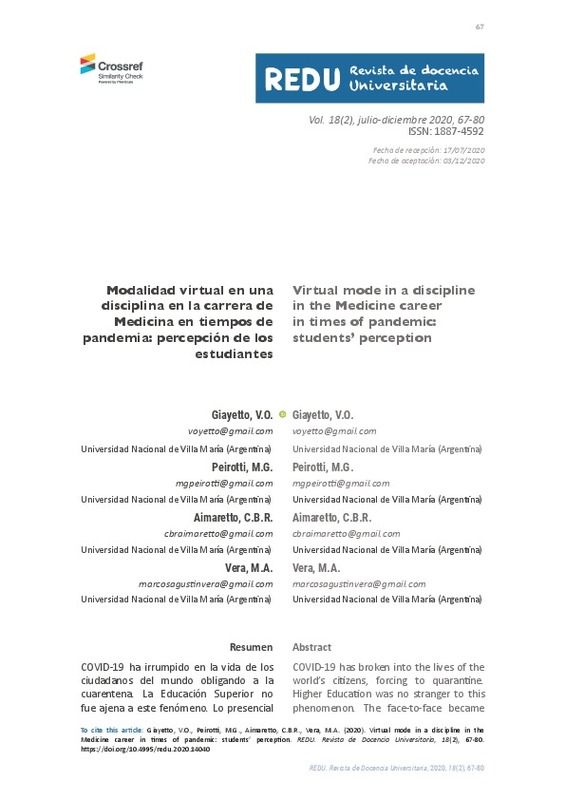Borges, F. (2005). La frustración del estudiante en línea. Causas y acciones preventivas. Digithum (en línea) 2005, (7). (fecha de consulta: 15 de julio de 2020) ISSN: 1575- 2275. Disponible en: https://www.redalyc.org/articulo.oa?id=55000706
Choi, H., Lee Y., Jung, I., Latchem C. (2013). The extent of and reasons for non reenrolment: A case of Korea National Open University. The International Review of Research in Open and Distributed Learning, 14(4). https://doi.org/10.19173/irrodl.v14i4.1314
Conrad, D.L. (2002). Engagement, Excitement, Anxiety, and Fear: Learners' Experiences of Starting an Online Course, American Journal of Distance Education, 16(4), 205-226. https://doi.org/10.1207/S15389286AJDE1604_2
[+]
Borges, F. (2005). La frustración del estudiante en línea. Causas y acciones preventivas. Digithum (en línea) 2005, (7). (fecha de consulta: 15 de julio de 2020) ISSN: 1575- 2275. Disponible en: https://www.redalyc.org/articulo.oa?id=55000706
Choi, H., Lee Y., Jung, I., Latchem C. (2013). The extent of and reasons for non reenrolment: A case of Korea National Open University. The International Review of Research in Open and Distributed Learning, 14(4). https://doi.org/10.19173/irrodl.v14i4.1314
Conrad, D.L. (2002). Engagement, Excitement, Anxiety, and Fear: Learners' Experiences of Starting an Online Course, American Journal of Distance Education, 16(4), 205-226. https://doi.org/10.1207/S15389286AJDE1604_2
Dabbagh, N. (2007). The online learner: characteristics and pedagogical implications Contemporary Issues in Technology and Teacher Education, Vol. 7(3), 217-226.
de Miguel Díaz, F., San Fabián Maroto, J.L., Belver Domínguez, J.L., Argüelles Laviana, M.C. (2011). Evaluación de la satisfacción de los participantes en la formación profesional para el empleo. Revista Electrónica de Investigación y Evaluación Educativa, 17(1). https://doi.org/10.7203/relieve.17.1.4120
Dupin-Bryant P. (2004). Pre-entry variables related to retention in online distance education. American Journal of Distance Education, 18(4), 199-206. https://doi.org/10.1207/s15389286ajde1804_2
Duque, L.C., Duque, J.L., Surinach, J. (2013). Learning outcomes and dropout intentions: an analytical model for Spanish universities. Educational Studies, 39(3), 261-284. https://doi.org/10.1080/03055698.2012.724353
Fozdar, B., Kumar, L., Kannan, S. (2006). Study of the Factors Responsible for the Dropouts from the BSc Programme of Indira Gandhi National Open University. The International Review of Research in Open and Distributed Learning, 7(3). https://doi.org/10.19173/irrodl.v7i3.291
Frankola, K. (2001). Why online learners dropout. Workforce Management, 80, 53-58.
Galusha, J.M. (1998). Barriers to learning in distance education. Interpersonal computing and technology: an electronic journal for the 21st century. 1998. Disponible en: http://www.infrasctruction.com/barriers.htm (fecha de consulta 15 de julio 2020)
García Aretio, L. (2019). El problema del abandono en estudios a distancia. Respuestas desde el Diálogo Didáctico Mediado. RIED. Revista Iberoamericana de Educación a Distancia, 22(1): 245-270. https://doi.org/10.5944/ried.22.1.22433
Grebennikov, L., Shah, M. (2012). Investigating attrition trends in order to improve student retention. Quality Assurance in Education, 20(3), 223-236. https://doi.org/10.1108/09684881211240295
Jun, J. (2005). Understanding E-dropout? International Journal on E-Learning, 4(2), 229- 240. https://doi.org/10.1007/978-3-540-31849-1_23
Meza Cano, J.M. (2010). La interacción profesor-alumno en la educación a distancia. Revista Educ@upn. Revista Universitaria, 3. ISSN: 2007-2686
Moncada Mora, L. (2014). La integración académica de los estudiantes universitarios como factor determinante del abandono de corto plazo. Un análisis en el Sistema de Educación Superior a Distancia del Ecuador. RIED. Revista Iberoamericana de Educación a Distancia, 17(2), 173-196. https://doi.org/10.5944/ried.17.2.12683
Montalvo, D.R. (2012). La retención y la deserción en línea: fenómeno de un modelo educativo virtual. HETS Online Journal, 2(2). Muilenburg L., Z. Berge. (2005). Student barriers to online learning: A factor analytic study. Distance Education, 26:1, 29-48. https://doi.org/10.1080/01587910500081269
Prendergast, G.A. (2003). "Keeping online student dropout numbers low", Global-Ed. com, 2003. [Online: 15 de Julio de 2020]. Disponible en: http://www.globaled. com/articles/GerardPrendergast2003.pdf
Roso-Bas, F., Pades, A., García, E. (2016). Emotional variables, dropout and academic performance in Spanish nursing students. Nurse Education Today, 37, 53-58. https://doi.org/10.1016/j.nedt.2015.11.021
Rugeles Contreras, P.A., Mora González, B., Metaute Paniagua, P.M. (2015). El rol del estudiante en los ambientes educativos mediados por las TIC. Revista Lasallista de Investigación (en línea), 12(2), 132-138. https://doi.org/10.22507/rli.v12n2a14
Simpson, O. (2013). Student retention in distance education: are we failing our students? Open Learning: The Journal of Open, Distance and-Learning, 28(2), 105-119. https://doi.org/10.1080/02680513.2013.847363
Street, H. (2010). Factors Influencing a Learner's Decision to Drop-Out or Persist in Higher Education Distance Learning. Online Journal of Distance Learning Administration, 13(4).
Tresman, S. (2002).Towards a Strategy for Improved Student Retention in Programmes of Open, Distance Education: A Case Study from the Open University UK. International Review of Research in Open and Distance Learning, 3(1), 1-11. https://doi.org/10.19173/irrodl.v3i1.75
Zambrano, W.R., Medina García, V.H., Martín García, AV. (2010). Nuevo rol del profesor y del estudiante en la educación virtual. Dialéctica: Revista de Investigación, 26, 51-62. ISSN-e 0123-2592
Zimmerman, J. (2020). Coronavirus and the Great Online-Learning Experiment. Chronicle of Higher Education, March 10, 2020.
[-]









